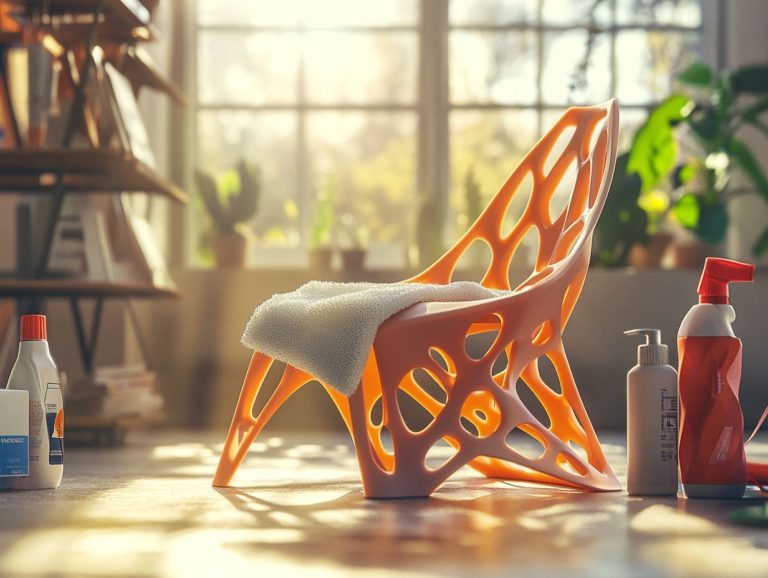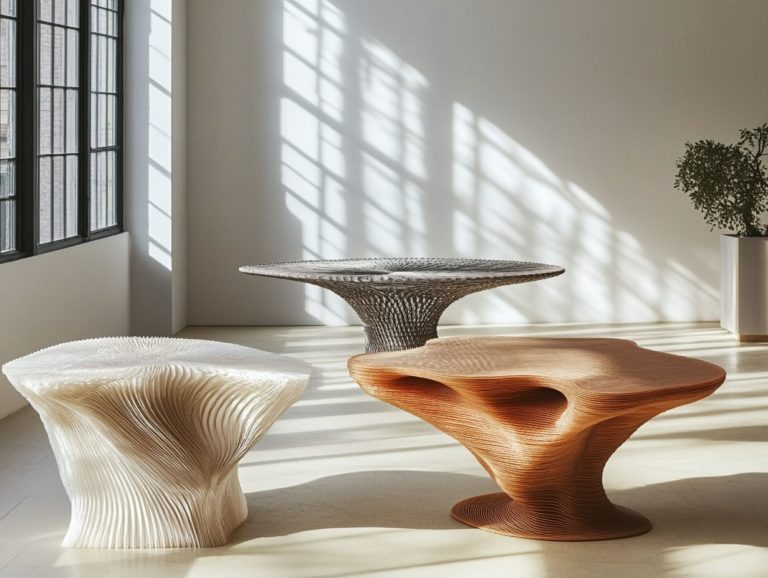5 Questions to Ask Before Buying 3D-Printed Furniture
As 3D-printed furniture becomes increasingly popular, it’s essential for you to grasp what distinguishes it from traditional options.
Whether you re evaluating the materials, durability, or the printing processes involved, asking the right questions can significantly influence your decision-making.
Get ready to explore five essential questions to consider before investing in 3D-printed furniture, focusing on customization options, costs, and environmental impacts.
This article will weigh the advantages and disadvantages, empowering you to choose wisely for your home. Dive in to uncover everything you need to know!
Contents
- Key Takeaways:
- 1. What Material Is Your Furniture Made Of?
- 2. How Durable Will Your Furniture Be?
- 3. What Is the Printing Process Used?
- 4. Can the Furniture Be Customized?
- 5. What Is the Cost and Lead Time for Production?
- Is 3D-Printed Furniture Environmentally Friendly?
- Frequently Asked Questions
- What is 3D-printed furniture?
- Why should I consider buying 3D-printed furniture?
- Is 3D-printed furniture durable?
- What are some important factors to consider before buying 3D-printed furniture?
- Can I customize 3D-printed furniture to fit my specific needs?
- How can I ensure that the 3D-printed furniture I purchase is high quality?
Key Takeaways:

- Consider the material used in 3D-printed furniture as it can affect the overall quality and lifespan of the piece.
- Ask about the durability of the furniture to ensure it can withstand regular use and last for a reasonable amount of time.
- Understand the printing process used to ensure the furniture meets your expectations and fits your design aesthetic.
1. What Material Is Your Furniture Made Of?
Your choice of material is crucial for both aesthetics and functionality when it comes to 3D-printed furniture. Materials like PLA and ABS polymers are popular among designers and DIY enthusiasts, thanks to advancements in 3D printing technologies, particularly Fused Deposition Modelling (FDM), a method that layers melted plastic to create solid shapes. This choice influences not just print quality and durability, but also the overall user experience, essential for educational projects or industrial applications.
Beyond PLA and ABS, consider materials like PETG and Nylon, which have unique properties. PETG offers excellent impact resistance, making it ideal for items that need to withstand wear and tear, especially in commercial environments. Meanwhile, Nylon is prized for its flexibility and strength, perfect for intricate designs and load-bearing capabilities.
Educational institutions are increasingly harnessing these materials for hands-on projects, allowing students to dive into practical applications of 3D printing. Industries also benefit from tailored solutions that meet their specific functional needs, showcasing the versatility of these innovative materials.
2. How Durable Will Your Furniture Be?
The durability of 3D-printed furniture is a significant concern for you, especially regarding print quality and how well the pieces stick together. Understanding 5 ways 3D-printed furniture can save you money can help you assess how these elements can profoundly influence longevity and overall maintenance costs.
Several factors, including your choice of materials, play a crucial role in how well the furniture withstands everyday use. For example, while Fused Deposition Modeling (FDM) employs thermoplastics that may be more susceptible to wear and environmental conditions, Stereolithography (SLA) offers finer details and a stronger, more durable finish.
Engaging in routine maintenance tasks such as cleaning and checking for structural integrity can extend the lifespan of these items significantly. By thoughtfully considering these aspects, you ll be empowered to choose wisely about your 3D-printed investments.
3. What Is the Printing Process Used?
The printing process behind 3D-printed furniture varies significantly, with methods like Fused Deposition Modelling (FDM), Stereolithography (SLA), and Selective Laser Sintering (SLS) each offering distinct advantages and challenges tailored to your specific needs.
Take FDM, for example. It’s celebrated for its compatibility with a wide range of thermoplastic materials, enabling you to create sturdy and versatile designs.
On the other hand, SLA employs resin materials that yield incredibly precise and detailed prints, though the speed may leave something to be desired. Then there’s SLS, which excels when working with powdered materials, allowing for complex geometries without the hassle of support structures.
In this landscape, technical support is vital. Quick troubleshooting and expert guidance can dramatically reduce downtime and improve print quality, leading to a more satisfying experience for you as the user.
Ready to make an informed decision on your 3D-printed furniture? Explore the cost of 3D-printed furniture further or reach out for more information!
4. Can the Furniture Be Customized?

Customization stands out as one of the most exciting features of 3D-printed furniture. It enables you to create unique designs tailored precisely to your preferences and needs.
With user-friendly design software and tools at your disposal, you can easily navigate everything from student projects to professional endeavors.
This flexibility opens the door to remarkable creativity and innovation. Both beginners and experienced designers alike can experiment with shapes, colors, and materials that perfectly complement their environments.
For example, educational institutions can harness this technology to craft furniture that accommodates diverse learning styles. Think of adjustable desks that serve both collaborative and individual study sessions.
On the consumer front, you can personalize your living space by designing customized shelving units or ergonomic chairs that fit your specific body contours. This illustrates the smooth combination of practical needs and aesthetic desires through contemporary design tools.
5. What Is the Cost and Lead Time for Production?
Understanding the costs and lead times associated with 3D-printed furniture production is essential for you, whether you’re a consumer or a business navigating budget constraints. Exploring ways to personalize your 3D-printed furniture can also help maximize your investment.
You want cost-effective solutions that don t sacrifice quality or delivery speed.
Several key factors significantly influence these variables, with the types of materials you choose playing a crucial role in overall costs. The printer’s speed can either shave time off your delivery or stretch it out, depending on the design’s complexity and the settings you select.
Regular maintenance of 3D printers is vital for maintaining optimal printing efficiency. Neglecting this can lead to delays and increased costs due to inferior outputs or mechanical failures.
Understanding these factors helps you make better choices for your budget and schedule.
Is 3D-Printed Furniture Environmentally Friendly?
The environmental impact of 3D-printed furniture is exciting and deserves your attention, especially as materials like PLA (polylactic acid) and other polymers gain traction for their sustainable properties.
These materials present a compelling alternative to traditional furniture manufacturing methods, addressing pressing concerns about waste and sustainability.
This innovative approach significantly minimizes material waste by using only what s necessary for production. It also cuts down on energy consumption during the printing process.
By harnessing advanced manufacturing techniques, many suppliers can create customized pieces on demand, drastically reducing overproduction and excess inventory.
With a range of recyclable and biodegradable materials now available, the environmental credentials of 3D printing are impressive! This promotes an eco-friendly mindset in furniture production.
As your awareness of these benefits grows, so does the demand for sustainable practices in the industry, paving the way for a shift towards greener solutions.
What Are the Advantages of 3D-Printed Furniture?
3D-printed furniture presents a wealth of advantages tailored just for you! These include unmatched customization options, rapid prototyping capabilities, and best practices for designing cost-effective solutions that accommodate a diverse array of consumer needs and aesthetic preferences.
This innovative approach significantly minimizes material waste, making it a more sustainable choice for those who are environmentally conscious.
Take, for instance, a popular project featuring modular shelving units. This not only highlights design flexibility but also results in minimal leftover material, reinforcing a commitment to environmental responsibility.
This furniture style gives you the power to iterate designs swiftly and efficiently. It leads to shorter production times a characteristic that consumer reviews frequently praise for its prompt delivery and unique, personalized aesthetics.
These examples illustrate how 3D-printed furniture can seamlessly blend functionality with artistic expression, transforming your living space into a true reflection of your personal style.
What Are the Disadvantages of 3D-Printed Furniture?

While 3D-printed furniture offers many advantages, exploring the unique benefits of 3D-printed furniture is important, as it also has some drawbacks that deserve your consideration. Issues like durability and potentially higher maintenance costs compared to traditional pieces can be significant.
The materials typically used in 3D printing may not be as strong as traditional wood or metal. This raises concerns about how well these items will hold up under everyday use.
Print quality can vary greatly based on the printer s settings and material selection. This inconsistency can lead to problems like rough finishes or fragile joints.
Make sure to prioritize proper care to keep your furniture looking great! Doing so will enhance the lifespan of your 3D-printed furniture and address its inherent limitations.
How Does 3D Printing Compare to Traditional Furniture Manufacturing?
When you compare 3D printing to traditional furniture manufacturing, several factors come into play, such as cost-effectiveness, print quality, and overall user experience. Keeping up with trends in 3D-printed furniture can significantly sway consumer preferences in today’s dynamic marketplace.
One striking difference lies in the variety of materials used in production. Traditional methods typically depend on wood, metal, and upholstery, limiting design possibilities.
In contrast, 3D printing opens the door to a vast selection of materials, including composites, which are materials made from two or more different substances, and biodegradable options.
Speed of production is another crucial factor. 3D printing enables rapid prototyping and customization, allowing designers to quickly respond to client feedback. Imagine a furniture startup that transformed its design cycle from months into mere weeks by embracing 3D printing. This demonstrates design flexibility and reflects a keen responsiveness to market demands.
Such agility provides a competitive edge, attracting consumers who value innovation and uniqueness in their selections.
What Are Some Common Concerns About 3D-Printed Furniture?
Common concerns about 3D-printed furniture often focus on print quality, durability, and the availability of help after you buy. To address these issues, consider following 5 tips for designing your own 3D-printed furniture, as these can significantly impact your trust and satisfaction as a consumer.
These worries can influence your purchasing decisions. If you perceive a product as subpar or feel it lacks adequate support, you might hesitate to invest.
When you’re uncertain about the longevity of your investment or anxious about post-purchase assistance, you’re less likely to complete the transaction.
To ease these concerns, manufacturers can take proactive measures, such as developing a comprehensive knowledge base that addresses frequently asked questions, offers maintenance tips, and highlights customer testimonials. By fostering transparency and support, they can enhance your confidence and elevate your satisfaction with their innovative furniture solutions.
What Should I Look for When Choosing a 3D-Printed Furniture Manufacturer?
When selecting a 3D-printed furniture manufacturer, consider the following factors:
- Print quality
- Consumer reviews
- Availability of technical support
Assessing the manufacturer s reputation can provide valuable insights into their reliability and product quality. You should also evaluate the range of material options they offer, as different materials can significantly influence both the durability and aesthetics of your final piece.
Robust help after you buy becomes essential in addressing any issues that may arise after your purchase. Engaging in thorough research and making informed choices is vital for achieving a rewarding and effective purchasing journey.
Start your journey to find the perfect 3D-printed furniture today!
Frequently Asked Questions

What is 3D-printed furniture?
3D-printed furniture is made using a 3D printer. This machine creates objects by layering materials like plastic or metal.
Why should I consider buying 3D-printed furniture?
3D-printed furniture offers many benefits, including customization, cost-effectiveness, and sustainability. To learn more about the process, check out this guide on how to find reliable 3D-printed furniture suppliers.
It allows for unique designs and can be made from recycled materials, making it a great choice for environmentally-friendly furniture.
Is 3D-printed furniture durable?
The durability depends on the materials used in the furniture. Some 3D-printed items can be just as durable as traditional furniture, while others may be less so.
Research the specific materials and their durability before making a purchase.
What are some important factors to consider before buying 3D-printed furniture?
Consider the materials used, design and customization options, cost, and durability.
Don’t forget to check the company’s reputation and experience.
Can I customize 3D-printed furniture to fit my specific needs?
Yes! One major advantage of 3D-printed furniture is its customization options.
Many companies let you customize the design, size, and color to meet your specific needs and preferences.
How can I ensure that the 3D-printed furniture I purchase is high quality?
Research the company’s reputation and experience before buying. Check samples of their work to ensure quality.
Reading reviews and asking for referrals can help ensure the furniture meets your expectations.






